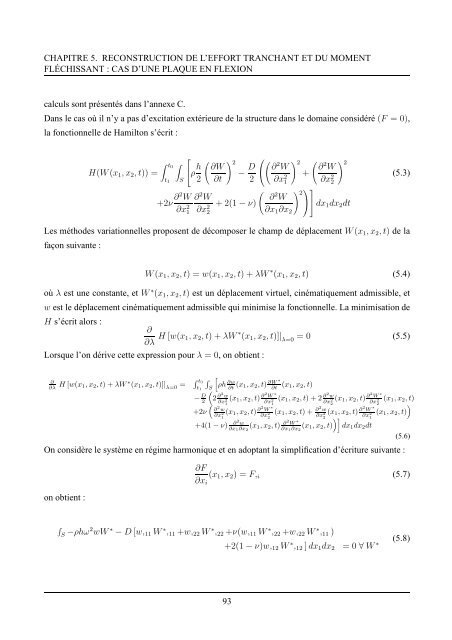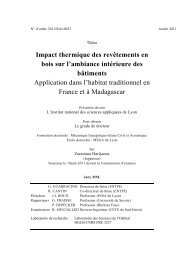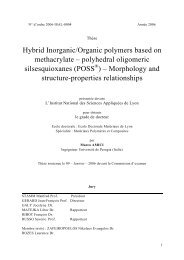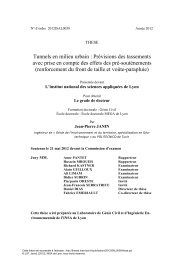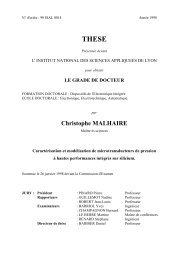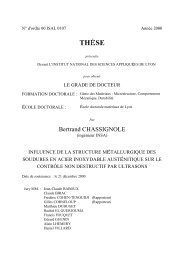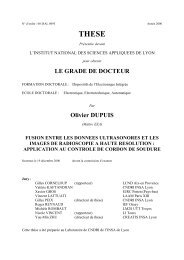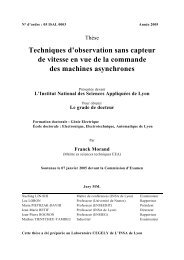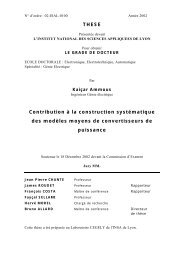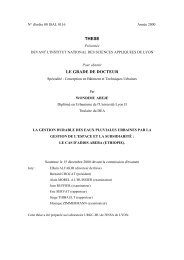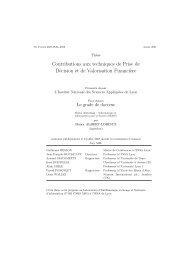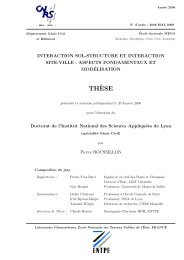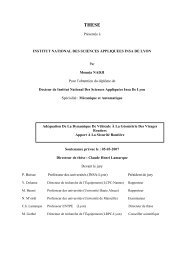Identification d'efforts aux limites des poutres et plaques en flexion ...
Identification d'efforts aux limites des poutres et plaques en flexion ...
Identification d'efforts aux limites des poutres et plaques en flexion ...
You also want an ePaper? Increase the reach of your titles
YUMPU automatically turns print PDFs into web optimized ePapers that Google loves.
CHAPITRE 5. RECONSTRUCTION DE L’EFFORT TRANCHANT ET DU MOMENT<br />
FLÉCHISSANT : CAS D’UNE PLAQUE EN FLEXION<br />
calculs sont prés<strong>en</strong>tés dans l’annexe C.<br />
Dans le cas où il n’y a pas d’excitation extérieure de la structure dans le domaine considéré (F = 0),<br />
la fonctionnelle de Hamilton s’écrit :<br />
⎡<br />
∫ t0<br />
H(W(x 1 , x 2 , t)) = ⎣ρ<br />
t 1<br />
∫S<br />
h ( ) ⎛ 2<br />
∂W<br />
− D (<br />
⎝ ∂ 2 ) 2 (<br />
W ∂ 2 ) 2<br />
W<br />
+<br />
(5.3)<br />
2 ∂t 2 ∂x 2 1 ∂x 2 2<br />
+2ν ∂2 W ∂ 2 (<br />
W ∂ 2 ) ⎞⎤<br />
2<br />
W<br />
+ 2(1 − ν) ⎠⎦dx ∂x 2 1 ∂x 2 1 dx 2 dt<br />
2 ∂x 1 ∂x 2<br />
Les métho<strong>des</strong> variationnelles propos<strong>en</strong>t de décomposer le champ de déplacem<strong>en</strong>t W(x 1 , x 2 , t) de la<br />
façon suivante :<br />
W(x 1 , x 2 , t) = w(x 1 , x 2 , t) + λW ∗ (x 1 , x 2 , t) (5.4)<br />
où λ est une constante, <strong>et</strong> W ∗ (x 1 , x 2 , t) est un déplacem<strong>en</strong>t virtuel, cinématiquem<strong>en</strong>t admissible, <strong>et</strong><br />
w est le déplacem<strong>en</strong>t cinématiquem<strong>en</strong>t admissible qui minimise la fonctionnelle. La minimisation de<br />
H s’écrit alors :<br />
∂<br />
∂λ H [w(x 1, x 2 , t) + λW ∗ (x 1 , x 2 , t)]| λ=0<br />
= 0 (5.5)<br />
Lorsque l’on dérive c<strong>et</strong>te expression pour λ = 0, on obti<strong>en</strong>t :<br />
∂<br />
∂λ H [w(x 1, x 2 , t) + λW ∗ (x 1 , x 2 , t)]| λ=0<br />
= ∫ t 0<br />
t 1<br />
∫S<br />
− D 2<br />
(<br />
(<br />
+2ν<br />
[<br />
ρh ∂w<br />
∂t (x 1, x 2 , t) ∂W∗<br />
∂t<br />
(x 1 , x 2 , t)<br />
2 ∂2 w<br />
∂x 2 1<br />
∂ 2 w<br />
∂x 2 1<br />
(x 1 , x 2 , t) ∂2 W ∗<br />
∂x 2 1<br />
(x 1 , x 2 , t) ∂2 W ∗<br />
∂x 2 2<br />
(x 1 , x 2 , t) + 2 ∂2 w<br />
∂x 2 2<br />
(x 1 , x 2 , t) + ∂2 w<br />
∂x 2 2<br />
+4(1 − ν) ∂2 w<br />
∂x 1∂x 2<br />
(x 1 , x 2 , t) ∂2 W ∗<br />
∂x 1∂x 2<br />
(x 1 , x 2 , t)<br />
(x 1 , x 2 , t) ∂2 W ∗<br />
∂x 2 2<br />
(x 1 , x 2 , t) ∂2 W ∗<br />
)]<br />
∂x 2 1<br />
dx 1 dx 2 dt<br />
(x 1 , x 2 , t)<br />
)<br />
(x 1 , x 2 , t)<br />
On considère le système <strong>en</strong> régime harmonique <strong>et</strong> <strong>en</strong> adoptant la simplification d’écriture suivante :<br />
on obti<strong>en</strong>t :<br />
(5.6)<br />
∂F<br />
∂x i<br />
(x 1 , x 2 ) = F, i (5.7)<br />
∫<br />
S −ρhω2 wW ∗ − D [w, 11 W ∗ , 11 +w, 22 W ∗ , 22 +ν(w, 11 W ∗ , 22 +w, 22 W ∗ , 11 )<br />
+2(1 − ν)w, 12 W ∗ , 12 ] dx 1 dx 2 = 0 ∀ W ∗ (5.8)<br />
93


